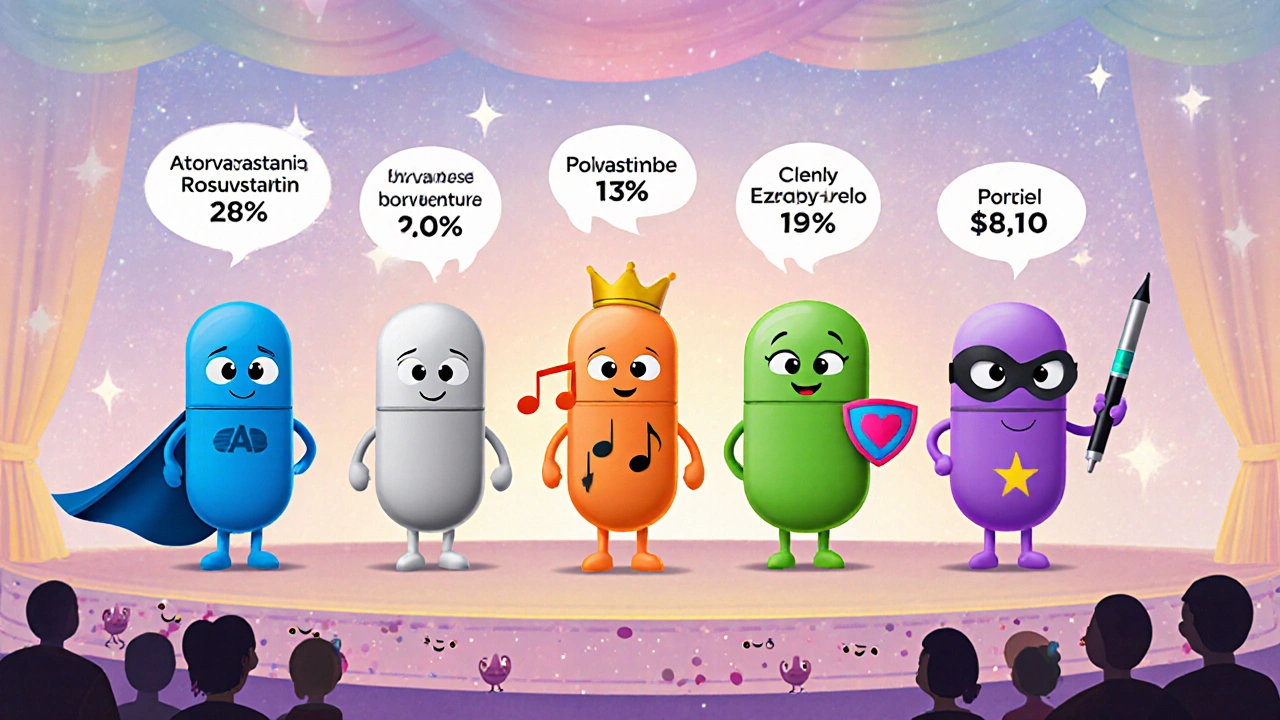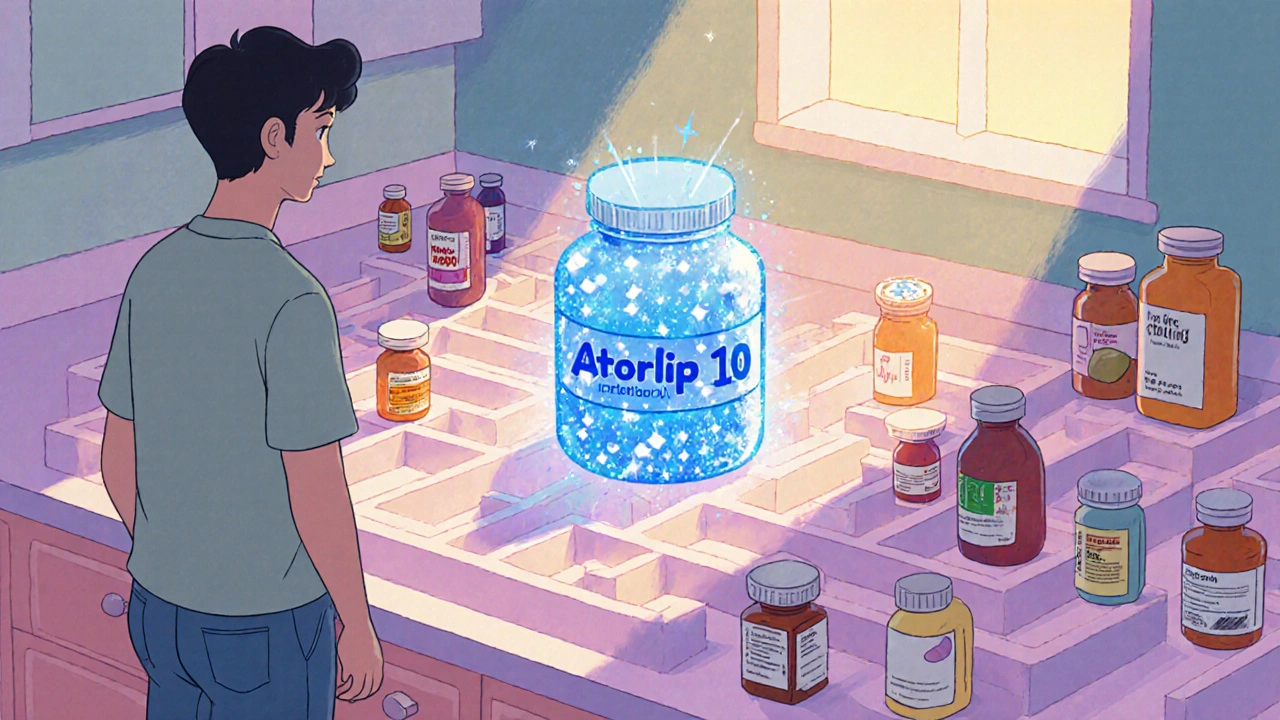Cholesterol Drug Comparison Tool
Find Your Best Cholesterol Medication
Answer a few simple questions about your cholesterol levels, side effect concerns, and budget to see which cholesterol medication might be most suitable for you.
Quick Takeaways
- Atorvastatin (Atorlip 10) is a high‑potency statin that lowers LDL by 30‑50%.
- Rosuvastatin and Simvastatin offer similar LDL drops but differ in cost and drug‑interaction profiles.
- Ezetimibe works outside the HMG‑CoA pathway and is useful when statins cause muscle pain.
- PCSK9 inhibitors like Evolocumab deliver up to 60% LDL reduction but cost a few thousand pounds a year.
- Choosing the right drug depends on your cholesterol level, existing meds, kidney function, and budget.
Trying to pick a cholesterol‑lowering pill can feel like sorting through a maze of brand names, doses, and side‑effects. This guide cuts through the clutter by putting Atorvastatin (sold as Atorlip 10) side‑by‑side with the most common alternatives. By the end you’ll know which medication fits your health goals, your wallet, and your lifestyle.
What is Atorvastatin (Atorlip 10)?
Atorvastatin is a synthetic, high‑potency statin that inhibits HMG‑CoA reductase, the key enzyme the liver uses to make cholesterol. Marketed in the UK as Atorlip 10, it typically comes in a 10 mg tablet taken once daily.
How Atorvastatin Lowers Bad Cholesterol
The drug blocks the conversion of HMG‑CoA to mevalonate, a building block of cholesterol. With less cholesterol made in the liver, LDL receptors increase, pulling more LDL‑C out of the bloodstream. The result is a 30‑50 % drop in LDL‑C after 4-6 weeks of therapy.
Key Attributes of Atorvastatin
- Typical dose: 10‑80 mg daily, with 10 mg marketed as Atorlip 10.
- Onset of action: LDL reduction noticeable within 2 weeks.
- Half‑life: ~14 hours, allowing flexible dosing time.
- Common side‑effects: Muscle aches, elevated liver enzymes, occasional GI upset.
- UK price (2025): Approx. £8‑£12 per month for the generic 10 mg tablet.

Alternatives on the Market
Below are the most prescribed statins and non‑statin drugs that doctors consider when Atorvastatin isn’t ideal.
Rosuvastatin (Crestor)
- Potent LDL reducer (40‑55 % at 10‑20 mg).
- Longer half‑life (≈19 hours) - good for patients who miss doses.
- Higher cost (£12‑£18 per month) but fewer drug‑interaction concerns.
Simvastatin (Zocor)
- Moderate potency (20‑35 % LDL drop at 20‑40 mg).
- Risk of CYP3A4 interactions - watch out with certain antibiotics.
- Cheapest statin on the UK market (≈£5 per month).
Pravastatin (Pravachol)
- Gentle on muscles - preferred for patients with prior statin‑induced myopathy.
- Lower LDL reduction (15‑30 % at 20‑80 mg).
- Cost similar to Simvastatin (£5‑£7 per month).
Ezetimibe (Ezetrol)
- Blocks intestinal cholesterol absorption - works independently of HMG‑CoA reductase.
- Typical LDL drop 15‑20 % alone; up to 35 % when combined with a low‑dose statin.
- Monthly price around £30‑£35.
Evolocumab (PCSK9 inhibitor)
- Injectable monoclonal antibody that prevents PCSK9 from degrading LDL receptors.
- Achieves 50‑60 % LDL reduction, even in statin‑intolerant patients.
- Costly - roughly £2,500‑£3,000 per year in the NHS special‑access scheme.
Fenofibrate (Fibricor)
- Fibrate class, primarily lowers triglycerides and modestly raises HDL.
- Often added to statins when triglycerides remain high.
- Monthly cost about £12‑£15.
Niacin (Niaspan)
- Vitamin B3 derivative; raises HDL by up to 30 % and lowers LDL modestly.
- Flushed skin and liver toxicity limit its use.
- Cheapest of the lot (£3‑£5 per month) but poorly tolerated.
Side‑Effect Snapshot
Statins share a core set of side‑effects, but the incidence varies by molecule.
| Side‑effect | Atorvastatin | Rosuvastatin | Simvastatin | Pravastatin |
|---|---|---|---|---|
| Muscle pain | 7‑10 % | 5‑8 % | 10‑12 % | 4‑6 % |
| Liver enzyme rise | 1‑3 % | 1‑2 % | 2‑4 % | 1‑2 % |
| Blood sugar increase | 0.5‑1 % | 0.4‑0.8 % | 0.6‑1.2 % | 0.3‑0.7 % |
Cost Comparison (2025 UK Prices)
| Drug | Class | Typical Dose | LDL ↓ % | Common Side‑effects | Approx. Monthly Cost |
|---|---|---|---|---|---|
| Atorvastatin (Atorlip 10) | Statin | 10 mg daily | 30‑50 % | Muscle aches, liver enzymes | £10 |
| Rosuvastatin | Statin | 10‑20 mg daily | 40‑55 % | Headache, mild GI upset | £15 |
| Simvastatin | Statin | 20‑40 mg daily | 20‑35 % | CYP3A4 interactions, muscle pain | £5 |
| Pravastatin | Statin | 20‑80 mg daily | 15‑30 % | Low muscle risk | £6 |
| Ezetimibe | Cholesterol absorption inhibitor | 10 mg daily | 15‑20 % (alone) | Diarrhea, fatigue | £32 |
| Evolocumab | PCSK9 inhibitor | 140 mg sub‑Q2‑4 weeks | 50‑60 % | Injection site reactions | £250 (per month) |
| Fenofibrate | Fibrate | 145 mg daily | 20‑30 % triglyceride ↓ | GI upset, gallstones | £13 |
| Niacin | Vitamin B3 derivative | 500‑1000 mg daily | 10‑15 % LDL ↓, 30 % HDL ↑ | Flushing, liver toxicity | £4 |

When to Choose Atorvastatin Over Others
If your LDL‑C is well above target (< 2.5 mmol/L for most adults) and you have no history of statin intolerance, Atorvastatin is often the first pick. It delivers strong LDL drops at a modest price and its once‑daily dosing fits easy into a morning routine.
Consider these scenarios:
- Kidney impairment: Choose pravastatin or low‑dose rosuvastatin - they’re less dependent on renal clearance.
- Drug‑interaction nightmare: Rosuvastatin or pravastatin have fewer CYP‑mediated clashes.
- Statin‑related muscle pain: Switch to pravastatin, add ezetimibe, or move to a PCSK9 inhibitor.
- Very high triglycerides: Pair a statin with fenofibrate or consider a high‑dose omega‑3 supplement.
How to Talk to Your Doctor
Bring these points to the appointment:
- Your latest lipid panel (LDL, HDL, triglycerides).
- Any current medications, especially antibiotics, antifungals, or HIV drugs.
- History of muscle aches, liver disease, or diabetes.
- Budget constraints - some NHS prescriptions may be free, but brand‑name or PCSK9 drugs often need a special approval.
Clear communication helps your clinician match the right drug to your risk profile.
Frequently Asked Questions
Can I switch from Atorvastatin to Rosuvastatin without a wash‑out period?
Yes. Both are long‑acting statins, so you can simply stop Atorvastatin and start Rosuvastatin the next day. Your doctor may monitor liver enzymes for a few weeks after the change.
Why is my doctor adding ezetimibe to my Atorvastatin dose?
Ezetimibe works by blocking cholesterol absorption in the gut, so the two drugs hit the problem from opposite ends. This combo can push LDL down an extra 10‑15 % when statin alone isn’t enough.
Are PCSK9 inhibitors like Evolocumab covered by the NHS?
They’re available through a specialist‑prescribed 'high‑intensity' pathway for patients with familial hypercholesterolaemia or those who cannot tolerate any statin. Expect a thorough eligibility assessment.
What should I do if I experience muscle pain on Atorvastatin?
First, don’t stop the drug abruptly. Tell your GP - they might lower the dose, switch to pravastatin, or add a low‑dose ezetimibe. A creatine kinase (CK) blood test can confirm if it’s a statin‑related issue.
Is it safe to take a statin while pregnant?
No. All statins, including Atorvastatin, are classified as pregnancy‑category X. They’re linked to birth defects, so they must be stopped before conception and during pregnancy.
How often should my lipid panel be checked after starting a new cholesterol drug?
Typically after 4‑6 weeks, then again at 3‑month intervals until stable. Your doctor may space out tests later if levels stay in target.
Armed with this side‑by‑side view, you can have a focused chat with your pharmacist or GP and land on the medication that best fits your numbers, your health history, and your budget.


Taylor Haven
October 22, 2025 AT 12:25It is deeply troubling how the pharmaceutical oligarchy has engineered a market where we are forced to choose between a cheap statin that may be laced with hidden side‑effects and a billion‑pound injectable that most of us will never afford, all while they silently profit from our mortal fear of heart disease. The very fact that Atorvastatin, a synthetic molecule, is marketed under the guise of a modest "Atorlip 10" is a ploy designed to lull the public into complacency, obscuring the truth that these drugs are a patchwork of corporate interests masquerading as medical necessity. Every table of LDL reduction percentages is curated to highlight only the favorable outcomes, while the long‑term consequences-such as the subtle rise in blood glucose or the potential for myopathy-are buried in fine print that no layperson could decipher without a PhD in pharmacology. Moreover, the rise of PCSK9 inhibitors like Evolocumab, which cost thousands per year, reflects a calculated strategy to create a dependency on high‑margin treatments that only the wealthiest can sustain. This stratification is not merely economic; it is a deliberate social engineering tactic that deepens health inequities across class lines.
Consider the way the UK NHS, under pressure from budget constraints, selectively finances these high‑cost therapies only for a privileged few diagnosed with familial hypercholesterolemia. The rest of the population is left to navigate a labyrinth of generic statins, each with its own interaction profile, as if they were being forced into a dangerous game of roulette. The data tables presented in the guide, while seemingly objective, omit the fact that the incidence of muscle pain for Atorvastatin climbs as high as ten percent when paired with common antibiotics-a fact that the industry’s marketing departments actively suppress.
In addition, the seemingly innocuous advice to "talk to your doctor" is a thin veil for an industry‑wide campaign that trains physicians to become de facto sales agents for these products. The subtle nudges to combine ezetimibe with Atorvastatin, for instance, inflate prescription volumes for a drug that itself costs twice as much as a generic statin, yet offers only a marginal incremental LDL reduction. This incrementalism is a hallmark of the profit‑driven model: it encourages polypharmacy, increases the patient’s pill burden, and ultimately boosts the bottom line for pharmaceutical conglomerates.
We must also recognize the geopolitical dimension of this health crisis. The global supply chain for statins is dominated by a handful of manufacturers in a few countries, leaving nations vulnerable to price manipulation and shortages that can be weaponized for political leverage. When a sudden spike in demand for Atorvastatin occurs, the ripple effect can destabilize entire healthcare systems, especially in low‑income regions that rely on these essential medicines.
Thus, the moral imperative for every informed citizen is to demand transparency, to scrutinize the motivations behind each recommendation, and to push for policies that prioritize public health over corporate profit. The guide you have before you is a useful starting point, but never forget that the truth lies beneath the surface of these glossy tables and cost comparisons.
Sireesh Kumar
November 3, 2025 AT 01:12Wow, this reads like a thriller novel set in a pharmacy-dramatic, intense, and a little over the top, but you’ve nailed the part about checking interactions. I’ve seen patients in Delhi panic over the cost of PCSK9 inhibitors, so the budget talk really hits home. Also, the bit about “talk to your doctor” feels like a safety net after the conspiracy storm you described.
Jonathan Harmeling
November 14, 2025 AT 14:59While the guide is thorough, it glosses over the moral responsibility of prescribing physicians to consider lifestyle changes before jumping straight into potent statins.
Ritik Chaurasia
November 26, 2025 AT 04:45In India we emphasize diet and yoga first; pushing a high‑cost pill without considering cultural practices is an aggressive oversight.
Holly Green
December 7, 2025 AT 18:32This guide nails the basics, but watch out for hidden costs.
Marrisa Moccasin
December 19, 2025 AT 08:19Seriously!!!; I mean, have you really checked the fine print???; The pharma lobby is probably hiding something, right???; It’s all a massive cover‑up; Trust no one!!